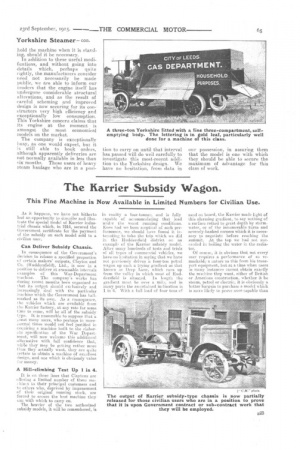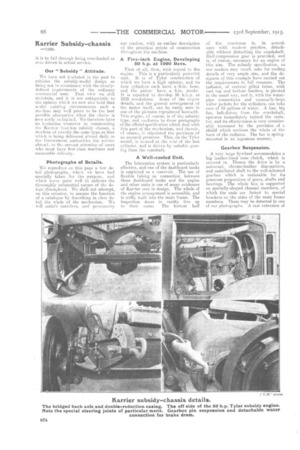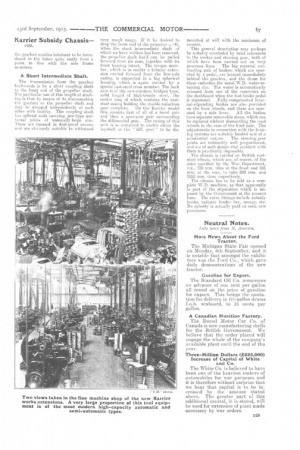The Karrier Subsidy Wagon.
Page 5

Page 6

Page 7

If you've noticed an error in this article please click here to report it so we can fix it.
This Fine Machine is Now Available in Limited Numbers for Civilian Use.
As it happens, we have not hitherto had an opportunity to describe and illustrate the special model of 'Karrier industrial chassis which, in 1914, secured the Government certificate for the payment of. the subsidy on each model sold to a eiv ilian user.
Can Deliver Subsidy Chassis.
In consequence of the Government's decision to release a specified proportion of certain makers' outputs, Clayton and Co. (Huddersfield), Ltd., is now in a rosition to deliver at reasonable intervals examples of this War-Department machine. The company's works has during recent. months been organized so that its output should exclusively and increasingly deal with the particular machine which the Government has hallmarked as its own. As a consequence, he vehicles which are available from the Karrier factory, at any rate for some time to conic, will be all of the subsidy type. It is reasonable to suppose that a i.eat many users, who perhaps in mereitormal times would not feel justified in acquiring a =chili& built to the elaborate specification of the War Department, will now welcome this additional alternative with . full confidence that, while they may be getting rather niece titan they actually want, they are quite certain to obtain a machine of -excellent design, and one which is obviously value for money.
A Hill-climbing Test Up l in 4.
It. is on those lines that Claytons are offering a limited number of these maoblin.s to their principal customers and to others who, deprived by impressment of their original running stock, are forced to secure the best machine they can with which to carry on.
The heavier of the two authorized subsidy models, it will he remembered, is
in reality a four-tonner, and is fully capable of accommodating that load under the worst running conditions. Even had we been sceptical of such performance, we should have found it interesting to take the trip which we did in the Huddersfield district on an example of the Karrier subsidy model. After many hundreds of tests arid trials of all typos of commercial vehicles, we have no hesitation in saying that we have not previously driven a. four-ton petrol wagon up such a trying gradient as that known as Deep Lane, which runs up from the valley in which most. of Huddersfield is situated. In length the gradient must he over a mile, and in many parts the. ascertained inclination is 1 in 4. With a full load of four tons of sand on board, the Karrier made light of this alarming gradient, to say nothing of a surface rutted to great depth by storm. water, or of the innumerable turns and severely-banked corners which it is necessary -to negotiate before reaching the summit. At the top we had not succeeded in boiling the water in the radiator.
Of course, it is obvious that not every user requires a performance of so remarkabk a nature as this from his transport equipment, but, at atime when usera in many instances cannot obtain exactly the machine they want, either of British or American construction, whether it be steam, petrol or electric, it is obviously a better bargain to purchase a model which is niece likely to prove. over-capable than it is to fail through being over-loaded or over driven in actual service.
Our " Subsidy " Attitude.
We have not hesitated in the past to criticise the subsidy-model design as being not in accordance with the clearlydefined requirements of the ordinary commercial user. That view we still maintain, and it is not antagonistic to the opinion which we-now also hold that under existing circumstances such a machine may well prove to be the best possible alternative when the choioe is nece:sarily so luntod. We therefOre have no hesitation whatever in commending the Karris.kr four-ton subsidy chassis, a machine of exactly the same type, as that which is being delivered almost daily to the Government authorities for service abroad, to the earnest attention of users who most have first-class machines and reasonable delivery.
Photographs of Details..
We reproduce on this page a few detail photographs, which we have had specially taken for the purpose, and which serve quite well to indicate the thoroughly Substantial nature of the design throughout. We shall not attempt, on this occasion, to assume the function of a catalogue by describing in close detail the whole of the mechanism. We will satisfy' ourselves, and presumaldy
our readers, with an outline description of the principal points of construction throughout the machine.
A Five-inch Engine, Developing 50 h.p. at 1000 Revs.
First of all, then, with regard to the engine. This is a particularly powerful unit. It is of Tylor construction of which we have a high opinion, and its four cylinders each have -a bore, and the piston, have a 6-in. stroke. It is reported to develop 50 b.h.p. at 1000 revolutions. Some of the engine details, and the general arrangement of the motor itself, can be easily seen in one of the pictures reproduced herevtith. This engine, of course, is of the subsidy type, and conforms to those paragraphs of the official specification which deal with this pact of the mechanism, and therein, of course, is stipulated the provision of an encased governor. This, on the Tyler model, is located at the rear of the last cylinder, and is driven by suitable gearing from the camshaft.
A Well-cooled Unit.
The lubrication system is particularly effective, and one of the dashboard tanks is employed as a reservoir. The use of flexible tubing as connection between these dashboard tanks and the engine and other units is one of many evidences of Karrier care in design. The whole of the engine arrangement is accessible, and is stiffly built into the main frame. The inspection doors in reality live up to their name. The bottom half of the crankcase is, in accordance with modern practice, detachable without disturbing the crankshaft. Half-compression gear is provided, and is, of course, necessary for an engine of this size. The subsidy specification, as our readers may recall, asks for cooling details, of very ample size, and the designers of this example have carried out, the requirements in full measure. The radiator, of vertical gilled tubes, with cast top and bottom headers, is pivoted in the usual way, and it, with the waterpipe connections and unusually-large water jackets for the cylinders, can take care of 10 gallons of water. A fine, big fan, belt-driven from the crankshaft, operates immediately behind the radiator, and its effectiveness is very considerably increased by the provision of a shield which encloses the whole of the back of the radiator. The fan is springmounted in an ingenious manner.
Gearbox Suspension,
A very large flywheel accommodates a big leather-hoed cone clutch, which is covered in. Thence the drive is by a universal, chrome-leather disc-pattern, and castellated shaft to the well-schemed gearbox which is noticeable for its generous proportions of gears, shafts and bearings. The whole box is supported on specially-shaped channel members, of which the ends are linked to special brackets on the sides of the main frame members. These may be detected in one of our photographs. A cast extension of
the gearbox enables lubricant to be introduced to the latter quite easily from a point in hue with the aide frame members.
A Short Intermediate Shaft.
The transmission from the gearbox bockwards is by a short coupling shaft to the front end of the propeller shaft. The partiesjar use of this length of shafting is that by means of its disconnection the gearbox or the propeller shaft end may be dropped independently of each other with facility. This coupling shaft has splined ends carrying jaw-type universal joints of unusually-large size. These are encased in dust-proof covers, and are obviously suitable to withstand
very rough usage. If it be desired to drop the front end of the proposer 0._•,ft, when the short intermediate shaft of which we have written has been removed, the propeller shaft itself can be pulled forward from its case, together with its front bearing intact. The torque member, which is in reality a tubular exten. elms carried forward from the live-axle casing, is supported in a big spherical housing, which is again carried by a special cast-steal cross member. The back axle is of the now-common bridged type, solid forged of high-tensile steel, the centre ring of winch contains the caststeet casing holding the double-reduction
gear complete. On the Karrier model this consists first of all of a bevel pair and then a spur-gear pair surrounding the differential gear. The casing of this unit is an contrived to enable either the layshaft or the " diff. gear " to be dis mounted at will with the minimum of trouble.
This general description may perhaps he suitably concluded by brief references to the brakes and steering gear, both of which have been carried out on very
generous lines. The big external contracting pair of brakes, which are operated by a pedal, are located immediately behind the gearbox, and the drum for these embodies the usual W.D. water-retaining tins. The water is automatically released from one of the reservoirs on the dashboard when the foot-brake pedal is depressed. Fully-compensated internal-expanding brakes are also provided Oil the back wheels, and these are oper
ated by a side lever. All the brakes have separate removable shoes, which can be replaced without dismantling the road wheels in the case of the hind pair. The adjustments in connection with the braking systems are suitably located and of a substantial nature. The steering-gear citsts are noticeably well proportioned, and are of such design that accident with them is practically impossible. The chassis is carried on British cast. steel wheels, which are, of course, of the sizes specified by the War Department, viz., 720 ram, rims at the front and 081 rum. at the rear, to take 880 mm. and 1050 mm, tires respectively.
The c.hassis has to be sold as a complete W.D: machine, as that apparently is part of the stipulation which is imposed by the Government at the !present time. The extra fittings include subsidy hooks, radiator fender bar, sprags, etc. No subsidy is actually paid on such new purchases.
Neutral Notes.
Late Isms!? from, N. America.
More News About the Ford Tractor.
The Michigan State Fair opened on Monday, 6th September, and it is-notable that amongst the exhibitors was the Ford C.o., which gaye daily demonstrations of the new tractor.
Gasoline for Export.
The Standard Oil Co. announces an advance of one cent per gallon all round on the price of gasoline for export. This brings the quotation for delivery in 110-gallon drums f.o.b. seaboard, to 18 cents per gallon.
A Canadian Munition Factory. The Russel Motor Car Co. of Canada is now manufacturing shells for the British Government. We believe that the order placed will engage the whole of the company's available plant until the end of the year.
Three-Million Dollars (1625,000) Increase of Capital of White and Co.
The -White Co. is believed to have been one of the heaviest. makers of automobiles for war purposes and it is therefore without surprise that we hear that capital is to .be increased by the amount stated above. The greater part of this additional capital, it is stated, will be used for extension of plant made necessary by war orders.




















